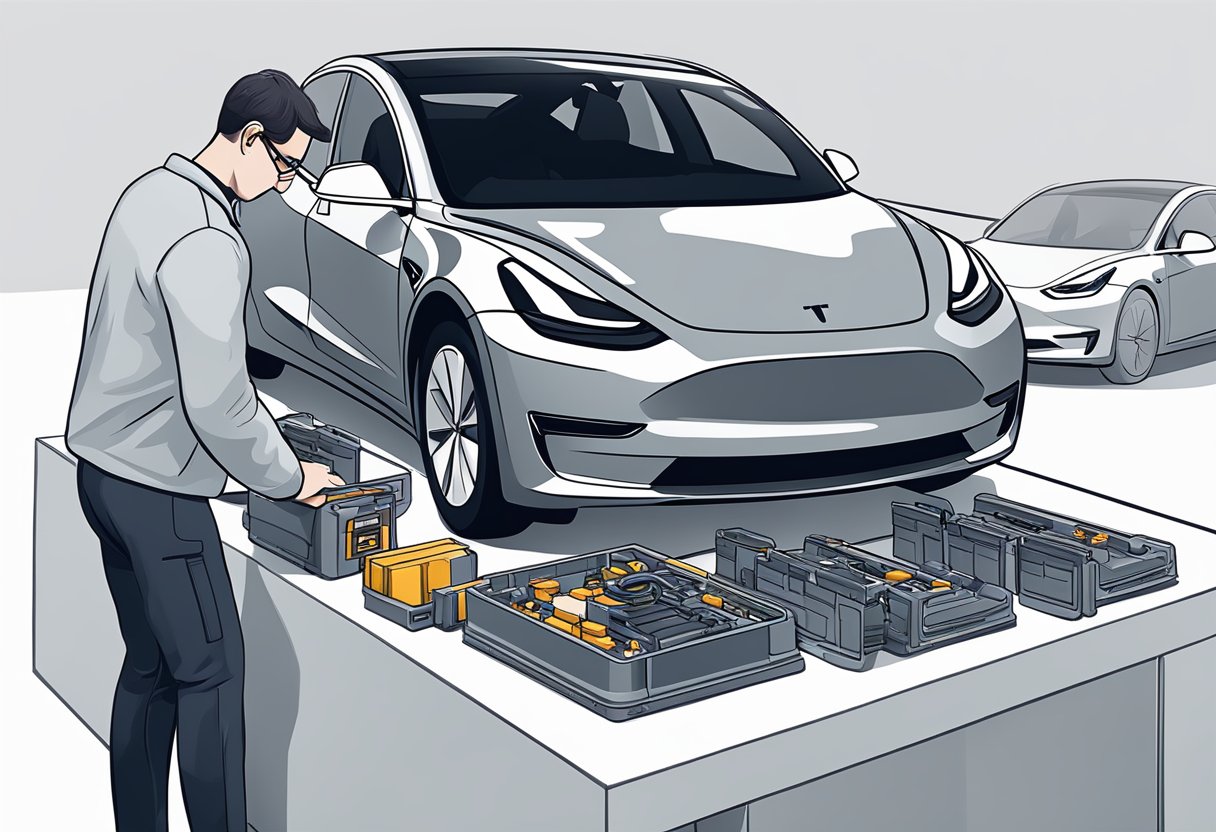As an electric vehicle (EV) enthusiast, understanding battery health is crucial to maintaining your Tesla Model 3’s performance and longevity. Battery degradation is the gradual loss of storage capacity over time, which is an inherent aspect of all lithium-ion batteries. For Tesla Model 3 owners, monitoring this degradation not only ensures that you get the most out of your vehicle but also helps in managing long-term maintenance and vehicle value.

Checking the battery health of your Tesla Model 3 involves keeping an eye on changes in the maximum range over time. When you fully charge your Tesla, the estimated range displayed on your dashboard is a good indicator of battery health. This figure should be compared against the typical range expected from a new battery under similar conditions. Minor discrepancies are normal, but a noticeable decline could signify battery degradation.
Additionally, several tools and methods can assist you in tracking the health of your Tesla’s battery more accurately. Third-party apps, like the Stats app, enable a more detailed analysis by providing insights into charging session history, tire pressure, and even comparing your vehicle’s phantom drain rate with other Tesla users. Regularly reviewing these insights helps maintain an accurate assessment of your Model 3’s battery health, allowing you to address potential issues proactively.
Understanding Battery Degradation
Your Tesla Model 3’s range and performance depend heavily on the health of its battery. Battery degradation is the loss of capacity over time, but many factors contribute to how and why this happens.
Defining Battery Degradation
Battery degradation is the gradual decline in the ability of a battery to hold a charge. It is measured by the loss of battery capacity—the total amount of energy a battery can store—over time. For your Tesla Model 3, this means that as the battery degrades, the maximum range the car can travel on a full charge diminishes.
Battery Degradation and Electric Vehicles
In electric vehicles (EVs) like the Model 3, battery degradation is an expected part of the lifecycle. However, the rate at which a battery loses capacity is influenced by many usage and maintenance factors. Knowing that your EV’s performance hinges on battery condition underlines the importance of regular health checks.
Chemistry’s Role in Degradation
The chemistry of an EV battery plays a pivotal role in its degradation rate. Tesla Model 3 batteries are Lithium-ion (Li-ion), which have a high energy density but can degrade through cycles of discharge and recharge. Chemical reactions within the cells are inevitable and contribute to a battery’s reduced lifespan.
Factors Affecting Tesla Model 3’s Battery Life
Several factors can affect the life of your Model 3’s battery:
- Temperature: Extremes—both hot and cold—can accelerate degradation.
- Charging habits: Frequent charging to full or discharging to empty can stress the battery.
- Usage patterns: High-speed driving and aggressive acceleration put more strain on the battery.
- Age: Simply put, the older the battery, the more it may have degraded from its original capacity.
Measuring the Battery Health
To effectively monitor the battery health of your Tesla Model 3, understanding its capacity, range estimation, and degradation patterns is critical.
State of Charge vs. Capacity
State of charge (SoC) refers to the current battery percentage, whereas capacity is the total amount of energy that your electric car’s battery can store. It’s important to distinguish between the two because a full SoC doesn’t necessarily mean your battery hasn’t degraded. Usable battery capacity is a more precise measurement for degradation as it reflects how much energy the battery can actually hold and deliver to your electric car.
Understanding the Range Estimation
The estimated range is how far your Tesla Model 3 can travel on a full charge, based on the usable battery capacity. This estimation is generated by the Battery Management System (BMS) and can fluctuate due to various factors, such as driving habits and environmental conditions. To assess battery health, observe if there’s a consistent decrease in the range over time, which can signal degradation.
Common Methods to Check Degradation
There are a few methods you can employ to check battery degradation:
- Monitoring Range Over Time: Keep a log of the estimated range after a full charge under similar conditions and note any significant drops.
- Check Battery Health Indicator: Access this through the Controls > Vehicle > Battery > Battery Health on your Tesla’s touchscreen.
- Physical Testing: Test the car’s range by driving until the battery is fully depleted, ideally under controlled conditions, to gauge actual performance against the estimated range.
Interpreting Tesla’s Battery Management System Data
Your Tesla’s BMS provides valuable data on battery health. Navigate to your car’s touchscreen display to find information on your battery’s state of charge, estimated range, and other vital statistics. Ensuring that your BMS is well-calibrated is crucial for accurate readings on the health and function of your electric car’s battery.
Practical Insights & Tips

In maintaining the health of your Tesla Model 3’s battery, consider how the real-world range, charging habits, and environmental temperatures play critical roles. By understanding and optimizing these factors, you can maximize the battery’s lifespan.
Gauging Real-World Range Degradation
To assess range degradation, routinely compare your Model 3’s fully charged estimated range against the original specifications. Monitor these figures periodically, noting any discrepancies which might indicate battery health decline. If there’s a significant range reduction, this points to potential degradation.
- Initial Range: Note the estimated range after a full charge at purchase.
- Current Range: Regularly note the estimated range after a full charge.
Tip: Use the Tesla app’s Battery Health Indicator to check the estimated range loss over time.
Impact of Charging Habits on Battery Health
Your charging routine directly influences battery health. Frequent DC fast charging or Supercharging can accelerate degradation. To preserve battery integrity:
- Prefer Level 2 charging at home or work.
- Set a charging limit below 100% for daily use to avoid overcharging stress.
- Reserve supercharging for long trips only.
Tip: Moderation in using fast charging facilities can prolong battery condition.
Temperature Effects on Battery Degradation
Extreme temperatures, either hot or cold, can negatively impact your battery’s health. Protect your vehicle from severe weather conditions:
- Hot Climates: Minimize exposure to direct sunlight. Use covered parking.
- Cold Climates: Precondition the battery using the Tesla app before driving.
Tip: Maintaining a moderate temperature where your Model 3 is parked helps prevent rapid degradation.
Maximizing Battery Lifespan
Long-term battery health relies on various best practices. By implementing thoughtful habits, you can extend the lifespan of your Tesla’s battery:
- Regularly rotate your tires to ensure even wear and efficient driving.
- Avoid depleting the battery completely; charge when reaching around 20% remaining.
Tip: Keep a consistent and battery-friendly driving and charging routine to promote longevity.
Tesla’s Model 3 Specifics and Warranty

When considering the health of your Tesla Model 3’s battery, it’s essential to understand the specifics of the long-range and performance models and the accompanying warranty coverage. High-mileage vehicles may also have special considerations.
Tesla Model 3 Long Range and Performance Variants
- Tesla Model 3 Long Range: Your model is equipped to cover a significant distance on a single charge, making it an excellent choice for both city driving and longer trips.
- Model 3 Performance: With a focus on speed and agility, this variant provides a swift driving experience without compromising on the high-efficiency synonymous with Tesla’s electric cars.
Warranty Coverage for Battery
Your Tesla Model 3’s battery is a vital component of your vehicle’s performance and longevity. It’s covered by a substantial warranty meant to reassure you:
- Basic Warranty: 4 years or 50,000 miles, whichever comes first.
- Battery and Drive Unit: 8 years or 120,000 miles for Long Range and Performance models, with a minimum 70% retention of battery capacity over this period.
High-Mileage Tesla Model 3 Considerations
A high-mileage Tesla Model 3 might affect your warranty coverage and battery health. Be vigilant about:
- Battery Performance: Slight degradation over time is normal but keep an eye on any significant changes in range or recharging patterns.
- Warranty Status: Always validate the current status of your vehicle’s warranty, particularly if you’re approaching high mileage benchmarks.

